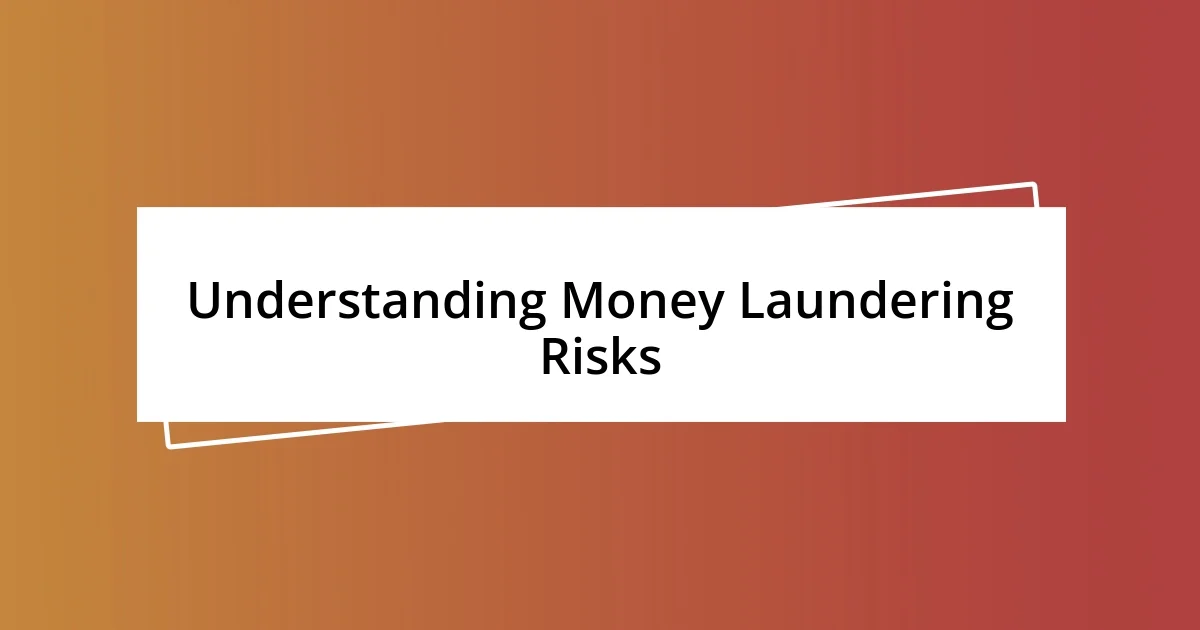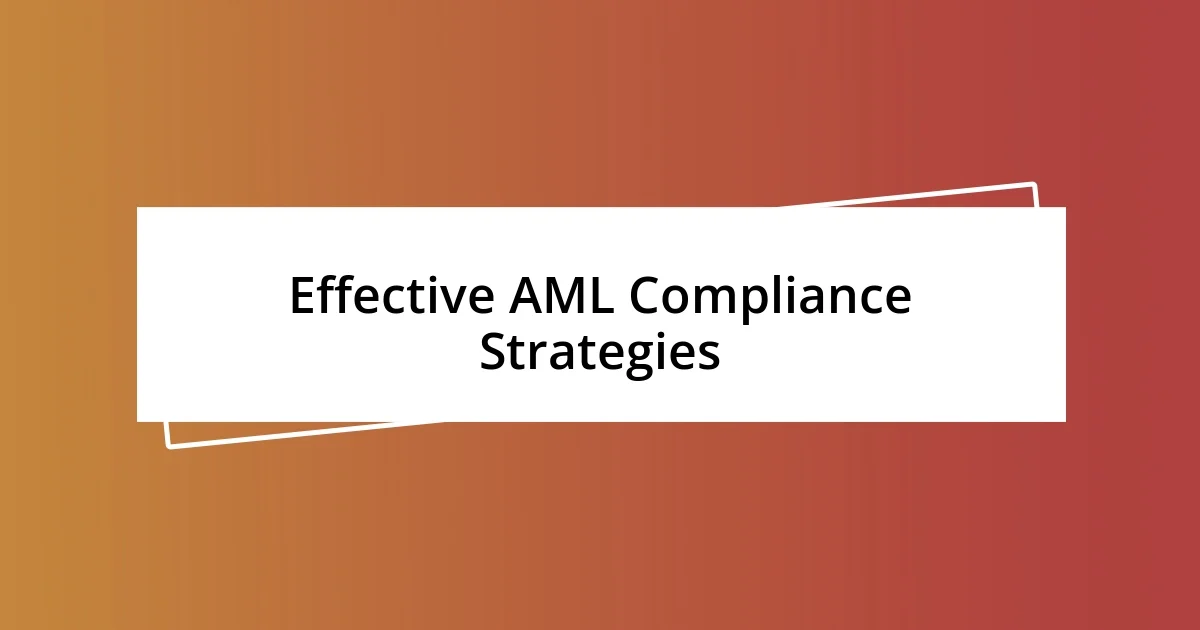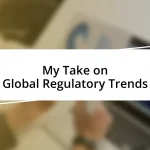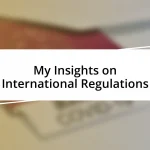Key takeaways:
- Recognizing the nuanced risks of money laundering, including shell companies and geographical vulnerabilities, is essential for maintaining ethical business practices and protecting against legal repercussions.
- Implementing strong Anti-Money Laundering (AML) measures not only safeguards financial integrity but also enhances trust among stakeholders and contributes to the broader fight against crime.
- Future AML efforts will increasingly rely on technology, such as AI, collaborative industry practices, and transparent regulatory demands to effectively address evolving money laundering tactics.

Understanding Money Laundering Risks
Understanding the nuances of money laundering risks is essential for anyone involved in finance or business. I remember sitting in a late-night seminar, the lecturer highlighting a case where a company unknowingly facilitated money laundering through a seemingly harmless transaction. It struck me how easily routine operations could become entangled in illicit activities, sparking my awareness of the need for vigilance in our financial dealings.
Risk can take many forms in the realm of money laundering. For instance, consider the role of shell companies, which often masquerade as legitimate businesses. They create a façade that can deceive even the most diligent compliance officer. Have you ever thought about how a seemingly innocent donation might be a front for laundering funds? Recognizing these subtleties is critical to mitigating risks effectively.
Investors and business owners should also be wary of geographical risks, as some regions have less stringent regulations around financial transactions. I recall a conversation with a colleague who emphasized the need to be cautious when engaging with partners in these areas. His experience illustrated the pitfalls of complacency—all it takes is one misstep in due diligence to expose a business to significant legal and reputational damage. Being aware of these dynamic risks not only protects businesses but also reinforces a commitment to ethical practices.

Importance of Anti-Money Laundering
The importance of anti-money laundering (AML) measures cannot be overstated. These protocols serve as a line of defense against the infiltration of illicit funds into the financial system. I often think back to my early days in finance when I witnessed a colleague lose a substantial investment due to lack of proper AML checks. It was a wake-up call that highlighted just how essential it is to have robust measures in place to safeguard the integrity of financial institutions.
Moreover, effective AML practices foster trust within the financial ecosystem. When companies enforce strict compliance, it reassures investors, clients, and the public that they are committed to ethical business operations. I once attended a conference where a speaker passionately discussed how adopting stringent AML protocols not only protects a company’s reputation but can actually elevate its market standing. It really resonated with me because it connects risk management directly to business success.
Finally, AML measures play a crucial role in the broader fight against crime. They disrupt the pathways that criminals use to launder money, making it increasingly difficult for them to operate with impunity. I recall feeling a sense of pride during a community meeting where law enforcement shared how local financial institutions thwarted a money-laundering scheme thanks to vigilant AML practices. It’s proof that by supporting these measures, we contribute to safer and more secure societies.
| Key Aspect | Importance |
|---|---|
| Protecting Financial Integrity | Prevents illicit funds from corroding the financial system |
| Building Trust | Enhances business credibility and investor confidence |
| Fighting Crime | Disrupts criminal organizations and their financial operations |

Key Anti-Money Laundering Regulations
Anti-money laundering (AML) regulations are crucial in creating a framework that guides how businesses should operate. From my experience, adhering to these regulations isn’t just about compliance—it’s about cultivating a culture of transparency and integrity within an organization. I still remember my first encounter with the Bank Secrecy Act (BSA) during training. It struck me how this regulation serves as a cornerstone by requiring financial institutions to report suspicious activity, which helps authorities trace illicit funds effectively.
- Bank Secrecy Act (BSA): Mandates that organizations report certain transactions and suspicious activities.
- USA PATRIOT Act: Expands the BSA, enhancing measures to identify and verify customer identities.
- Financial Action Task Force (FATF) Recommendations: Provides international standards for AML measures, promoting cooperation between countries.
- Money Laundering Control Act: Criminalizes money laundering, allowing prosecution for those involved in laundering transactions.
- European Union Anti-Money Laundering Directives: Sets regulations for member states to follow, ensuring a unified approach to AML.
Understanding these key regulations provides a solid foundation for anyone working in finance. I often think about one of my mentors who emphasized the importance of the FATF recommendations. She had firsthand experience with organizations that flouted these recommendations, leading to severe penalties and lasting reputational damage. That conversation really drove home the point that effective compliance isn’t just a legal obligation—it’s a strategic advantage that can fortify a business against potential risks.

Effective AML Compliance Strategies
To implement effective AML compliance strategies, it’s essential to prioritize risk assessment. From my understanding, identifying vulnerable areas within financial operations helps organizations allocate resources more effectively. I recall a project where we conducted a comprehensive risk assessment that revealed unexpected gaps in our client due diligence processes, which prompted immediate corrective actions. Isn’t it fascinating how sometimes, just a thorough evaluation can uncover critical insights?
Equally important is ongoing training for employees. I remember a particularly engaging training session that transformed my perspective on AML compliance. We dove into real-world scenarios, which highlighted the role each of us plays in detecting suspicious activities. This experience made me realize that embedding a culture of AML awareness among staff is crucial—having a well-informed team can be the first defense line against money laundering activities.
Lastly, utilizing technology can significantly enhance compliance efforts. I’ve seen firsthand how implementing advanced analytics and automated monitoring systems can streamline the detection of unusual transactions. It’s inspiring to think about how technology not only increases efficiency but also empowers financial institutions to stay ahead in the fight against money laundering. Doesn’t it feel reassuring to know that innovative solutions are at our disposal to tackle such complex challenges?

Challenges in Implementing AML
Implementing Anti-Money Laundering (AML) measures often faces significant challenges. One of the most pressing issues is the constant evolution of money laundering techniques. I once observed a case where a seemingly straightforward transaction turned out to be a complex web of illicit sources. How do we keep pace with such rapid changes? It requires continuous education and adaptability within organizations, which can be exhausting but is absolutely essential.
Another obstacle I’ve encountered is the resource constraint many companies face. Smaller institutions often lack the manpower needed to meet AML compliance effectively. I remember collaborating with a small bank that was overwhelmed by the reporting requirements; their team was stretched thin, leading to burnout and mistakes. It’s disheartening to witness dedicated employees struggle under such pressure—how can we expect them to perform optimally when they are pulled in so many directions?
Finally, the regulatory landscape itself can be a minefield. With varying requirements across different jurisdictions, organizations are at risk of non-compliance simply due to ignorance or oversight. I think back to a discussion I had with a compliance officer who shared how one missed deadline led to hefty fines for their institution. It made me realize that navigating this complexity isn’t just a task; it demands vigilance and a proactive approach to stay informed and compliant across borders.

Future of Anti-Money Laundering
As we look to the future of Anti-Money Laundering (AML), I envision an increasing reliance on technology, particularly artificial intelligence (AI). From my perspective, the potential of AI to analyze vast amounts of data quickly is truly game-changing. In one of my previous projects, we integrated AI tools that drastically reduced the time spent on identifying red flags, which allowed our team to focus more on thorough investigations. Imagine how enhanced algorithms could continuously learn from emerging trends in money laundering, ultimately enabling institutions to preemptively tackle threats even before they escalate.
I also believe that collaboration among institutions will become more critical. I recall a time when industry peers came together to share insights on emerging money laundering tactics. It was eye-opening to see how collective knowledge could foster more robust defenses. Don’t you think that by pooling resources and information, we can create a united front against financial crime? This cooperation could pave the way for creating standardized frameworks that make compliance easier and more cohesive across the board.
Moreover, regulatory bodies will likely push for more transparency from financial institutions. I often think about how the amount of data we manage could either be a burden or an asset. As regulators demand clearer reports and thorough audits, the stress on compliance teams will increase. I remember feeling overwhelmed by audit requirements in one organization, but it ultimately led to improved practices and a deeper understanding of our operations. It’s fascinating to consider how this pressure could simultaneously drive innovation and strengthen the financial ecosystem in the long run.

My Personal Recommendations on AML
When it comes to enhancing Anti-Money Laundering (AML) measures, one recommendation I have is to prioritize comprehensive training for all employees, not just those in compliance roles. I remember leading a workshop where a front-line staff member, initially skeptical, shared how understanding AML concepts helped her spot suspicious activities in daily transactions. This connection between training and real-world application really struck me. Have you ever considered how knowledge can empower frontline employees to act proactively rather than reactively?
In addition, I advocate for adopting a risk-based approach tailored to each organization’s unique context. I once consulted for a boutique financial firm that risked burnout due to a one-size-fits-all compliance framework. We shifted their focus to identifying specific vulnerabilities, allowing their team to streamline reporting processes. Isn’t it refreshing to think that not all compliance measures have to be burdensome? By aligning efforts with actual risk, institutions can work smarter, not harder.
Lastly, fostering an open culture where employees feel comfortable reporting concerns can dramatically improve AML efforts. I recall a situation where a junior analyst hesitated to raise a red flag during a meeting, fearing it was a false alarm. Eventually, the issue was escalated, revealing significant discrepancies. This experience taught me the vital role of psychological safety in compliance. How can we build an environment where everyone, regardless of role, feels empowered to speak up? Creating this type of culture may very well be the backbone of a successful AML strategy.












